Qiu X.G. (Ed.) High Temperature Superconductors
Подождите немного. Документ загружается.

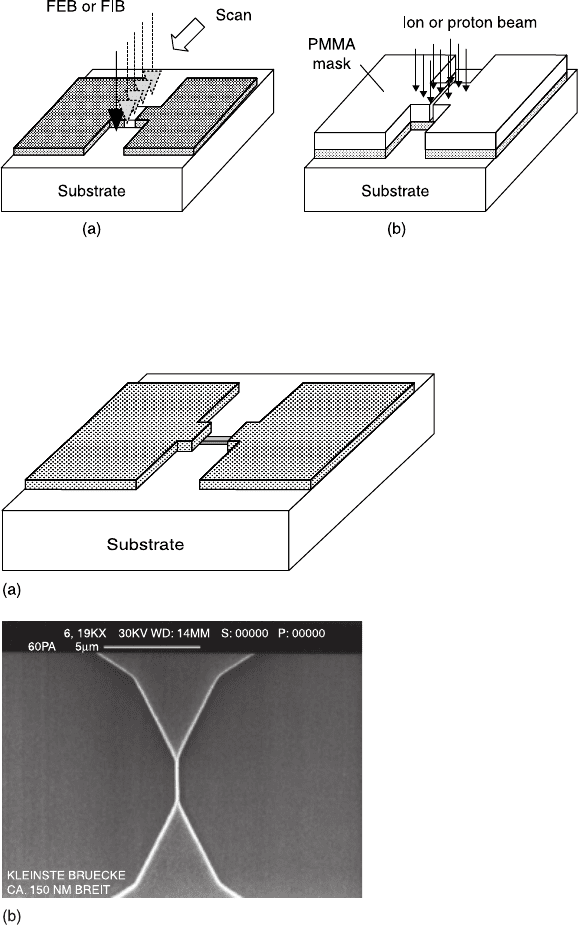
332 High-temperature superconductors
1
2
3
4
5
6
7
8
9
10
1
2
3
4
5
6
7
8
9
20
1
2
3
4
5
6
7
8
9
30
1
2
3
4
5
6
7
8
9
40
1
2
43X
© Woodhead Publishing Limited, 2011
8.12 Different types of modified microbridges (shown schematically):
(a) focussed beam written junctions, (b) modified bridge using mask
technology. PMMA (polymethylmethacrylate) is a negative photo resist
with high resolution.
8.13 High-T
c
nanobridge: (a) schematically, (b) SEM picture of a 150 nm
nanobridge (Schneidewind, 1995, Fig. 6.17, Copyright (1995) by Shaker,
Aachen). Reprinted with permission from Schneidewind H (1995),
Beiträge zum Ionenstrahlätzen von kryoelektronischen Bauelementen
auf der Basis von Kupratsupraleitern, Thesis at Friedrich-Schiller-
Universität Jena, Fig. 6.17, Copyright (1995) by Shaker.
High-T
c
Josephson junctions 333
1
2
3
4
5
6
7
8
9
10
1
2
3
4
5
6
7
8
9
20
1
2
3
4
5
6
7
8
9
30
1
2
3
4
5
6
7
8
9
40
1
2
43X
© Woodhead Publishing Limited, 2011
shows an example of a 150 nm bridge of YBCO by Schneidewind, 1995) an
additional modification of the material during the preparation process occurs and
leads to improvement of junction performance.
8.2.5 Intrinsic Josephson junctions
The intrinsic Josephson effects in the cuprates, where the superconducting CuO
2
-
planes are coupled via non-superconducting barrier layers within the unit cell of
the materials, can be used to produce series junction arrays. The number of
junctions depends on the thickness of the high-T
c
material between the electrodes.
Optimization of technology and a complex control of the preparation process
allows the reduction of the number of junctions to a few or even to one. There are
different technologies using mesa geometry of vertical stacks, stacks grown at
steps in the substrate, focussed ion beam cut single crystal or film structures and
planar ‘horizontal stacks’ grown on vicinal cut substrates, some examples of
which are shown in Fig. 8.14. Additional doping or external shunting of the
intrinsic arrays can be used to adjust the junction parameters or to enhance the
synchronization of the junctions within the array.
8.2.6 Hybrid junctions
Within the past few years hybrid junctions were developed where one electrode is
realized by a conventional LTS superconductor, but the other by a high-T
c
superconductor. Originally such junctions were used to demonstrate the d-wave
symmetry of HTS in contrast to conventional s-wave superconductors. This
offers new kinds of coupling of the two superconductors and results in junction
behaviour different from the conventional Josephson junctions. Such a hybrid
junction in Nb-Au-YBCO technology by Smilde et al. (2002b) is shown in
Fig. 8.15. Their behaviour can be used for different kinds of electronic devices in
logic circuits as well as for better understanding the physics of high-T
c
Josephson
junctions, e.g. the meandering effect in grain boundary junctions. The hybrid
junctions have, in general, the disadvantage that their working temperature is
determined by the conventional low-temperature superconductor.
8.3 Grain boundary junctions
8.3.1 Physics of grain boundary junctions
There is an excellent review on grain boundaries in high-T
c
superconductors by
Hilgenkamp and Mannhart (2002). Thus only the main features will be summarized
here. The different types of grain boundaries are usually classified according to
the displacement and the rotation of both crystalline parts. For rotational grain
boundaries there exist tilt and twist components of the misorientation which often
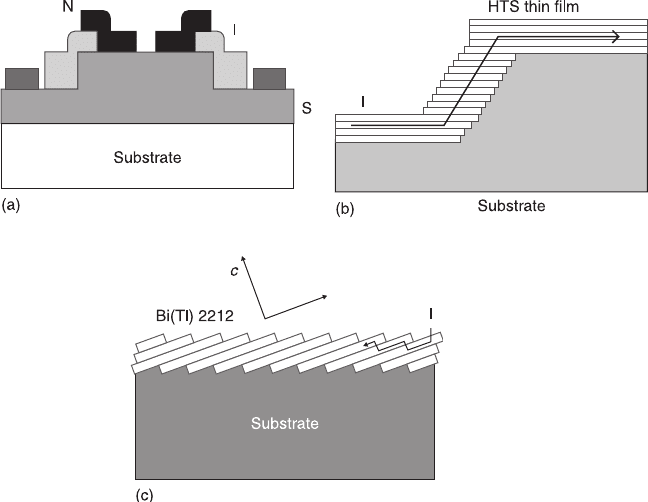
334 High-temperature superconductors
1
2
3
4
5
6
7
8
9
10
1
2
3
4
5
6
7
8
9
20
1
2
3
4
5
6
7
8
9
30
1
2
3
4
5
6
7
8
9
40
1
2
43X
© Woodhead Publishing Limited, 2011
appears in a combination, leading to so-called mixed boundaries. The tilt grain
boundary shows a rotation around one axis in the plane of the grain boundary
while the twist type is caused by a rotation around the axis perpendicular to this
plane. Symmetric grain boundaries have identical misorientation of both
grains with respect to the interface; otherwise they are asymmetric (see Fig. 8.5).
Figure 8.16 shows three examples of 90 degree grain boundaries: a 90° [010]-
twist boundary, a 90° [010]-basal-plane-faced tilt boundary and a symmetrical
90° [010]-tilt boundary. The latter two are frequently found in step-edge Josephson
junctions. An example is given in Fig. 8.17 for YBaCuO on an ion-milled 78° step
in a LaAlO
3
substrate where two 90° grain boundaries are formed at the upper and
lower ends of the step (Jia et al., 1992). This results in a series connection of two
8.14 Different types of intrinsic Josephson junction arrays
(schematically): (a) mesa; (b) step-stack array, reproduced from
Yurgens, 2000, Fig. 4, Copyright (2000) by IOP Publishing Ltd.
(reprinted with permission from Yurgens A (2000) ‘Intrinsic Josephson
junctions: recent developments’, Supercond. Sci. Technol. 13, R85–
R100, Fig. 4, Copyright 2000 by IOP Publishing Ltd); (c) bridge on
vicinal substrate, reproduced from Yurgens (2000), Fig. 5, Copyright
2000 by IOP Publishing Ltd. (reprinted with permission from Yurgens
A (2000) ‘Intrinsic Josephson junctions: recent developments’,
Supercond. Sci. Technol. 13, R85-R100, Fig. 5, Copyright 2000 by IOP
Publishing Ltd).
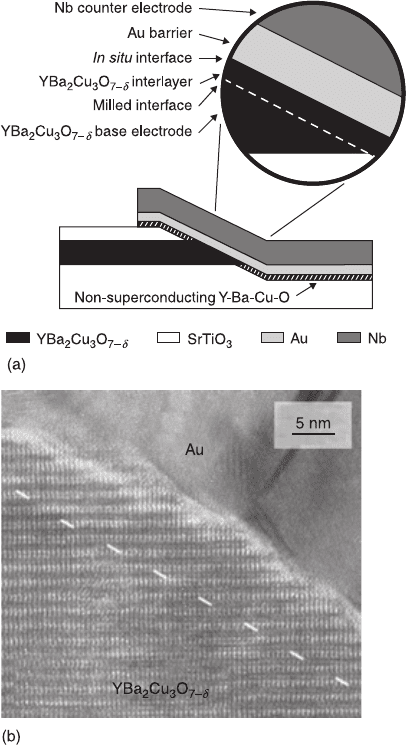
High-T
c
Josephson junctions 335
1
2
3
4
5
6
7
8
9
10
1
2
3
4
5
6
7
8
9
20
1
2
3
4
5
6
7
8
9
30
1
2
3
4
5
6
7
8
9
40
1
2
43X
© Woodhead Publishing Limited, 2011
8.15 YBCO/Au/Nb hybrid junction: (a) schematically, (b) TEM image
(Smilde, 2002b, Figs 1 and 2, Copyright (2002) by the American
Institute of Physics). Reprinted with permission from Smilde HJH,
Hilgenkamp H, Rijnders G, Rogalla H, and Blank DHA (2002), ‘Enhanced
transparency ramp-type Josephson contacts through interlayer
deposition’, Appl. Phys. Lett. 80, 4579–4581, Figs 1 and 2, Copyright
(2002) by the American Institute of Physics.
Josephson junctions instead of a single junction which can lead to problems in the
junction performance and noise (Seidel et al., 1995). To avoid the influence of one
of these junctions the angle of the step can be changed, resulting in different
values of the critical Josephson currents of both junctions. For MgO substrates
there is a technology by Du and Foley (2003) to avoid the grain boundary junction
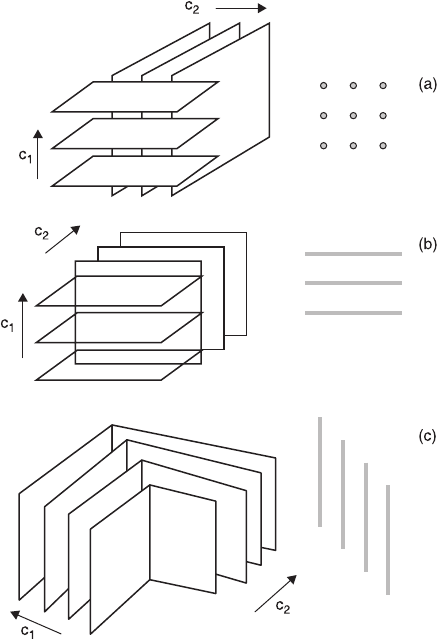
336 High-temperature superconductors
1
2
3
4
5
6
7
8
9
10
1
2
3
4
5
6
7
8
9
20
1
2
3
4
5
6
7
8
9
30
1
2
3
4
5
6
7
8
9
40
1
2
43X
© Woodhead Publishing Limited, 2011
at the lower edge of the step resulting in a single junction behaviour, Fig. 8.18.
Another important effect, the faceting or meandering, occurs along the grain
boundary interface, see e.g. Miller et al. (1995), Hilgenkamp et al. (1996),
Carmody et al. (2002). Facets with typical lengths of less than 100 nm are clearly
visible in the TEM images or AFM pictures. Their orientation and dimensions
depend on the high-T
c
material, the substrate material and its grain-boundary
configuration as well as on film deposition process. The three dimensional growth
of different oriented grains along the grain boundary results in a meandering path
8.16 Schematic diagrams of three types of 90° grain boundaries: (a)
[010]-twist, (b) [010]-basal-plane-face tilt, (c) symmetrical [010]-tilt.
The c-axis directions of the crystalline two parts of the bicrystal c
1
and c
2
are given by arrows (Tafuri and Kirtley, 2005, Fig. 22, Copyright
(2005) by IOP Publishing Ltd). Reprinted with permission from
Tafuri F and Kitley JR (2005), ‘Weak links in high critical temperature
superconductors’, Rep. Prog. Phys. 68, 2573–2663, Fig. 22, Copyright
(2005) by IOP Publishing Ltd.
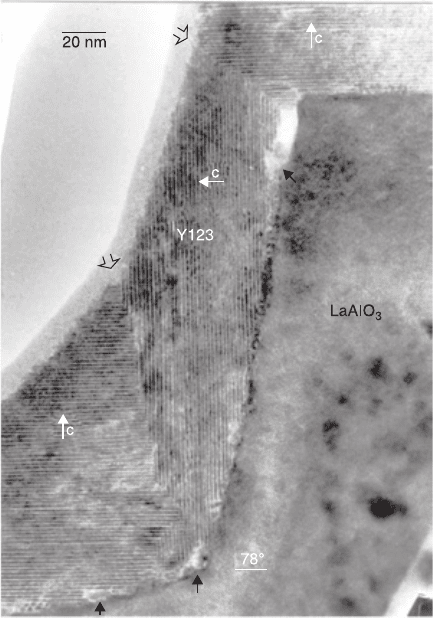
High-T
c
Josephson junctions 337
1
2
3
4
5
6
7
8
9
10
1
2
3
4
5
6
7
8
9
20
1
2
3
4
5
6
7
8
9
30
1
2
3
4
5
6
7
8
9
40
1
2
43X
© Woodhead Publishing Limited, 2011
with changes in the phases of the superconducting wave function corresponding
to the different crystal directions. Thus the Josephson current flows across some
facets in the direction opposite to the bias current. The order parameter orientations
can result in a
π
-phase shift across the junction and the faceting leads to an
inhomogeneous distribution of the Josephson current density including regions
with ‘negative’ critical current. This inhomogeneity causes anomalous magnetic
field dependencies of the critical current and leads to spontaneously generated
magnetic fluxes along the grain boundary, Fig. 8.19.
At the interfaces of the grain boundary the bending of the electronic band
structure causes space charge layers depressing the order parameter and the
8.17 TEM image of a YBaCuO step-edge junction on a LaAlO
3
substrate; open arrows indicate the two 90° grain boundary junctions
(Jia et al., 1992, Fig. 4, Copyright (1992) by Elsevier Science Ltd.).
Reprinted with permission from Jia CJ et al. (1992), ‘The microstructure
of epitaxial YBaCuO films on steep steps in LaAlO substrates’, Physica
C 196, 211–226, Fig. 4, Copyright (1992) by Elsevier Science Ltd.
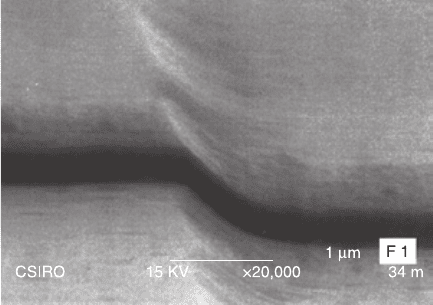
338 High-temperature superconductors
1
2
3
4
5
6
7
8
9
10
1
2
3
4
5
6
7
8
9
20
1
2
3
4
5
6
7
8
9
30
1
2
3
4
5
6
7
8
9
40
1
2
43X
© Woodhead Publishing Limited, 2011
8.18 SEM image of a YBaCuO step-edge junction on a MgO substrate
where there is no grain boundary junction at the lower end of the step
(Du and Foley, 2003, Fig. 1, Copyright (2003) by Elsevier Science Ltd).
Reprinted with permission from Du J and Foley CP (2003), ‘Trimming,
stability and passivation of YBCO step-edge junctions’, Physica C 391,
31–41, Fig. 1, Copyright (2003) by Elsevier Science Ltd.
I
c
R
N
-product. Additional doping of the grain boundary thus gives new possibilities
to improve the junction parameters, see Hilgenkamp and Mannhart (2002) and
references therein.
8.3.2 Preparation and performance of grain boundary
junctions
Depending on the junction type, the preparation technology has to be optimized to
produce time stable junctions with adjusted parameters in a reproducible way. The
critical Josephson current I
c
, the I
c
R
N
product at the expected working temperature
and also noise properties are of main interest. The selection of the junction type is
influenced by the whole device and circuit concept as well as the high-T
c
materials
for the films. There are a lot of commercial bicrystal substrates of high quality. The
good and reproducible quality of the junctions on such substrates is used if the high
cost of the substrates plays no role and the circuits can be designed in such a way that
the ‘parasitic’ junctions, which appear everywhere when superconducting lines cross
the grain boundary, have high critical currents without an influence on the ‘wanted’
junctions. The step-edge technology has the advantage to place the junction free on
the whole substrate and to avoid such ‘parasitic’ junctions. The step preparation by
ion beam etching requires additional processes in technology but is in general
possible for all substrates, even within buffer layers in multi-layer systems.
The biepitaxial junctions have similar advantages for a multi-layer technology
and with respect to their free placement on the substrate, but depending on the
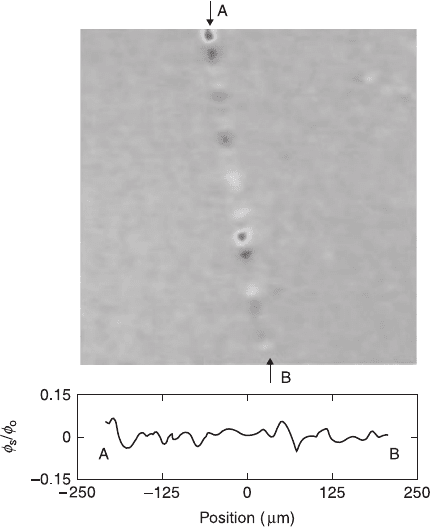
High-T
c
Josephson junctions 339
1
2
3
4
5
6
7
8
9
10
1
2
3
4
5
6
7
8
9
20
1
2
3
4
5
6
7
8
9
30
1
2
3
4
5
6
7
8
9
40
1
2
43X
© Woodhead Publishing Limited, 2011
materials only fixed angles of the grain boundary misfit are possible. In the
standard case this is the 45° tilt leading to very small critical currents corresponding
to the scaling law given in Fig. 8.6. Lombardi et al. (2002) demonstrated the
influence of the intrinsic d-wave effects on the angular dependence of the critical
current for different biepitaxial junctions. As an additional advantage the
meandering effect can be avoided resulting in homogeneous current distribution
and improved noise properties (see Carillo et al., 2000).
8.3.3 Selected applications of grain boundary junctions
As already mentioned, the bicrystal junctions are the most widely used type of
high-T
c
Josephson junctions. There is a wide range of applications, from single
junctions up to many arrays with over 100 junctions. Because the bicrystal
8.19 Scanning SQUID microscope image of an asymmetric 45°
[001]-tilt YBaCuO bicrystal grain boundary (marked by arrows A
and B). Self generated magnetic flux is apparent along the grain
boundary (Hilgenkamp and Mannhart, 2002, Fig. 58, Copyright (2002)
by the American Physical Society). Reprinted with permission from
Hilgenkamp H and Mannhart J (2002), ‘Grain boundaries in high-T
c
superconductors’, Rev. Mod. Phys. 74, 485–549, Fig. 58, Copyright
(2002) by the American Physical Society.
340 High-temperature superconductors
1
2
3
4
5
6
7
8
9
10
1
2
3
4
5
6
7
8
9
20
1
2
3
4
5
6
7
8
9
30
1
2
3
4
5
6
7
8
9
40
1
2
43X
© Woodhead Publishing Limited, 2011
SQUIDs will be discussed in the next chapter, some selected applications will
be given here which use the special performance of bicrystal junctions. The
I
c
R
N
-product of bicrystal junctions is in the order of 2 mV at 4.2 K (Hilgenkamp
and Mannhart, 2002). Values up to 8 mV have been reported by Poppe et al.
(2001) for [100]-tilt grain boundary junctions. This allows the detection of
radiation in the THz range by observation of Shapiro steps (Miyadera et al., 2005;
Kawayama, 2006) or by the Hilbert spectroscopy (Divin et al., 2001, 2002;
Shirotov et al., 2002).
A meandering superconducting line across the grain boundary gives an easy
way to realize a series array of junctions with quite similar parameters. Such
arrays can be used as voltage standards. In contrast to the usual standards, where
a zero-crossing Shapiro step of highest order (and thus of largest voltage) is used,
such digital standards work with the first Shapiro step in nonhysteretic
IV-characteristics. The necessary shunt resistor for the reduction of the McCumber
parameter can be realized with a gold layer on top of the grain boundary. An
example of a high-T
c
shunted bicrystal Josephson junctions array with 365
junctions was given by Klushin et al. (1996). Klushin and co-workers (2002)
demonstrated that accurate measurements of quantum voltage steps with such
arrays can be realized with an uncertainty of two parts in 10
8
suitable for
meteorological purposes. In comparison to usual electronic standards based on
Zener diodes, the HTS arrays permit one to ignore the influence of pressure,
temperature and humidity on the output voltage of the standard. Moreover, such
arrays are promising for development of an arbitrary voltage waveform synthesizer
with quantum-mechanical accuracy (Hamilton, 2000 and references therein). To
further improve the performance of HTS arrays, the Josephson junctions were
coupled to a Fabry-Perot resonator to enhance the effectiveness of interaction
with the electromagnetic field (Klushin et al., 2006; He et al., 2007). Figure 8.20
shows the IV-characteristics of two bicrystal junctions arrays of 182 [001]-tilt
junctions of YBCO on a 24° symmetrical bicrystal YSZ substrate with Au shunt
for different angles between the electric field and the film plane.
The biepitaxial junctions can be applied in quantum measurements, qubits and
π-circuitry because of their improved homogeneity and missing phase changes by
meandering of the grain boundary (Tafuri et al., 2004). Experimental observation
of the macroscopic quantum tunnelling (MQT) in biepitaxial Josephson junctions
was reported by Bauch et al. (2005). For qubits the intrinsic bistability of high-T
c
devices resulting on the time-reversal symmetry beaking of two coupled d-wave
superconductors becomes a major advantage. Amin et al. (2005) have demonstrated
a ‘silent’ qubit using submicron bicrystal junctions. The symmetry of this device
provides an operating point, which is intrinsically stable and protected against the
external field fluctuations.
Another promising application by Schilling et al. (2006) is the so-called
Josephson cantilever for microwave scanning microscopy where 22 bicrystal
junctions are placed on a LaAlO
3
substrate mounted on top of a piezo-driven
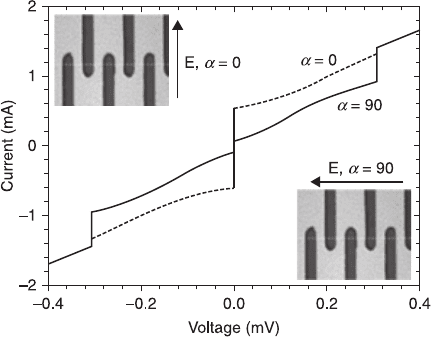
High-T
c
Josephson junctions 341
1
2
3
4
5
6
7
8
9
10
1
2
3
4
5
6
7
8
9
20
1
2
3
4
5
6
7
8
9
30
1
2
3
4
5
6
7
8
9
40
1
2
43X
© Woodhead Publishing Limited, 2011
spring, Fig. 8.21. The damping of the oscillation caused during the scanning of the
sample is used to image the near-field microwave radiation.
8.4 Artificial barrier junctions
8.4.1 Physics of artificial barrier junctions
The selection of the barrier material plays an important role because on one side
the conductivity mechanism through the barrier (normal metal, semiconductor,
insulator, etc.) is different but on the other side the high-T
c
superconducting
electrode leads to additional requirements. The barrier materials should not
interact with the high-T
c
material causing a degradation of the superconducting
parameters. This interacting includes chemical effects, diffusion processes and
the quality of the interface. Many types of junctions require heteroepitaxial growth
of the barrier material and one or even two high-T
c
electrodes. Thus there are a
very restricted number of barrier materials which have a small misfit in their
lattice parameters and thermal expansion coefficients in comparison to the high-T
c
superconductors. Perovskite-like materials like SrTiO
3
, PrBaCuO, NdCeCuO as
well as layers of high-T
c
superconductors with depressed or destroyed
superconducting properties are used. Additional buffer layers are used to adjust
lattice mismatch and different thermal expansion coefficients as well as to act as
interdiffusion barriers, e.g. CeO
2
or YSZ, but only if they do not enhance the total
8.20 IV-characteristics of shunted series arrays of grain boundary
Josephson junctions for different angle
α
between the electric field E
and the film plane (Klushin et al., 2006, Fig. 1, Copyright (2006) by the
American Institute of Physics). Reprinted with permission from Klushin
AM, He M, Yan SL, and Klein N (2006), ‘Arrays of high-T
c
Josephson
junctions in open millimeter wave resonators’, Appl. Phys. Lett. 89,
232505, Fig. 1, Copyright (2006) by the American Institute of Physics.
